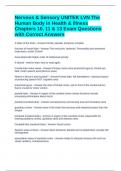-
1. Exam (elaborations) - Dementias and related disorders quiz 22 unitek lvn term 1 exam question s with correc...
-
2. Exam (elaborations) - Elimination and specimen collection exam questions with correct answers
-
3. Exam (elaborations) - Exam 1, semester 1, unitek vn questions with latest update
-
4. Exam (elaborations) - Final term 1 un itek lvn exam questions and answers
-
5. Exam (elaborations) - Final term 1 unitek exam questions and answers
-
6. Exam (elaborations) - Foundations unitek lvn elimination, enema administration & foley insertion exam quest...
-
7. Exam (elaborations) - Infection control (unitek lvn term 1) exam questions with correct answers
-
8. Exam (elaborations) - Intro to anatomy and physiology- unitek college exam questions with latest update
-
9. Exam (elaborations) - Intro to medical terminology unitek college eaxm questions and answers
-
10. Exam (elaborations) - Lvn unitek final- term 1 exam questions with correct answers
-
11. Exam (elaborations) - Midterm unitek term 1 questions with correct answers latest update
-
12. Exam (elaborations) - Nervous & sensory unitek lvn the human body in health & illness chapters 10, 11 & 13 ...
-
13. Exam (elaborations) - Pharm exam 2 unitek questions and answers
-
14. Exam (elaborations) - Quiz 3 vital signs documentation unitek exam questions and answers
-
15. Exam (elaborations) - Quiz 3&4 the nursing process vital signs documentation admission, transfer, discharge...
-
16. Exam (elaborations) - Quiz 4 lpn unitek exam study guide questions and answers
-
17. Exam (elaborations) - Quiz 19 unitek term 1 exam questions and answers
-
18. Exam (elaborations) - Surgical care med surg quiz 4 unitek lvn exam questions and answers
-
19. Exam (elaborations) - Term 1 final exam unitek college questions with latest update
-
20. Exam (elaborations) - Term 2 final un itek college exam questions and answers
-
21. Exam (elaborations) - Term 2 final unitek exam questions with correct answers
-
22. Exam (elaborations) - Unitek a&p quiz – musculoskeletal exam questions and answers
-
23. Exam (elaborations) - Unitek ch. 3 documentation exam questions with complete solutions
-
24. Exam (elaborations) - Unitek ch. 5 nursing process and critical thinking exam questions and answers
-
25. Exam (elaborations) - Unitek chapter 1 quiz exam questions and answers
-
26. Exam (elaborations) - Unitek college dosage calculations exam questions and answers
-
27. Exam (elaborations) - Unitek emt final exam review questions with latest update
-
28. Exam (elaborations) - Unitek emt final exam study guide questions and answers
-
29. Exam (elaborations) - Unitek emt patient assessment exam questions and answers
-
30. Exam (elaborations) - Unitek emt study final exam questions with latest update
-
31. Exam (elaborations) - Unitek exam 1 questions with correct answers
-
32. Exam (elaborations) - Unitek exam questions and answers
-
33. Exam (elaborations) - Unitek final study guide – fundamentals exam questions and answers
-
34. Exam (elaborations) - Unitek fon - ch. 11 admission, transfer, and discharge exam questions and answers
-
35. Exam (elaborations) - Unitek foundations of nursing exam questions and answers
-
36. Exam (elaborations) - Unitek history wellness communication exam questions with complete solutions
-
37. Exam (elaborations) - Unitek lvn nutrition & cultural quiz 2nd edition exam questions and answers
-
38. Exam (elaborations) - Unitek lvn safety term 1 exam questions with correct answers
-
39. Exam (elaborations) - Unitek lvn term 1 midterm review exam questions with verified
-
40. Exam (elaborations) - Unitek lvn test 1 - ch. 1,4,24 exam questions and answers
-
41. Exam (elaborations) - Unitek medical terminology exam questions with correct answers
-
42. Exam (elaborations) - Unitek nutrition part 2 exam questions with correct answers
-
43. Exam (elaborations) - Unitek ob exam 1 [ch 3-5] questions with latest update
-
44. Exam (elaborations) - Unitek pre req ch. 1 & 2 exam questions and answers
-
45. Exam (elaborations) - Unitek quiz 1 principles of pharmacology exam questions and answers
-
46. Exam (elaborations) - Unitek term 1 quiz 1 history wellness communication exam questions and answers
-
47. Exam (elaborations) - Unitek term 2 finals a practice set exam questions and answers
-
48. Exam (elaborations) - Unitek test #2 infection control exam questions with latest update
-
49. Exam (elaborations) - Unitek vn exam #1 questions and answers
-
Show more




